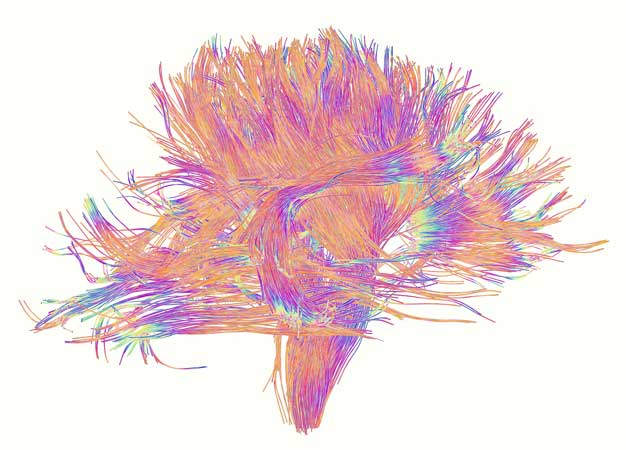Neural support cells implicated in childhood diseases of the brain's fatty high-speed transmission lines
Published online 24 November 2016

Improved models of the brain's communication network, known as white matter, could explain how diseases develop early in life.
© ALFRED PASIEKA/SCIENCE PHOTO LIBRARY/Getty
Japanese researchers have gained new insights into childhood brain diseases by manipulating gene expression in laboratory mice1. The work, led by Kenji Tanaka at Keio University's School of Medicine, offers a new view of the tissue that constitutes almost half the human brain.
White matter is the brain's communication network. It consists of long neural projections wrapped in fatty tissue that acts as insulation to speed up transmission of electrical signals between brain regions. Destruction or defective development of white matter leads to diseases called leukodystrophies, which include two disorders that Tanaka's work focused on ― Alexander disease and megalencephalic leukoencephalopathy with subcortical cysts (MLC).
Alexander disease and MLC both develop in infants, and both are caused by mutations in genes expressed in star-shaped brain cells called astrocytes. In Alexander disease, the gene GFAP seems to be involved, and MLC1 is implicated in MLC. Healthy astrocytes are known to help maintain white matter, but how the genetic mutations in these cells cause white matter degeneration is unclear.
One obstacle to solving the mystery was that mouse versions of these diseases either did not exhibit the characteristics of human leukodystrophy, or the disease only developed in old age. "We needed a new model in which the onset is in the developmental period to mimic the human disease," explains Tanaka.
His team developed new mouse models of astrocyte-related leukodystrophy using a technique they had previously developed to manipulate gene expression, called Flexible Accelerated STOP Tetracycline Operator (tetO)-knockin (FAST). The FAST system enabled the researchers to create mice in which Mlc1 was deleted and mice in which Mlc1 was overexpressed.
Deletion of Mlc1 caused leukodystrophy in old, but not young, mice. By contrast, mice with overexpressed Mlc1 developed white-matter abnormalities early in life, similar to the infantile onset of MLC in humans. Further experiments showed that overexpression of Mlc1 in astrocytes disrupted the energy-dependent balance of sodium and potassium inside and outside the cells, leading to astrocyte swelling and white matter damage.
While the implications for humans are not yet clear, Tanaka has some ideas. "Disruption of energy balance or the balance of sodium and potassium might cause human leukodystrophy, and correction of these imbalances could improve the disease."
The team plans to further investigate the role of astrocytes in the development and maintenance of white matter. They are also using the FAST technique to study the role of proteins that support neural growth and survival in resilience and susceptibility to stress in models of neuropsychiatric diseases.
Reference
- Sugio, S., Tohyama, K., Oku, S., Fujiyoshi, K., Yoshimura, T. et al. Astrocyte-mediated infantile-onset leukoencephalopathy mouse model. Glia 65, 150-168 (2016). | article